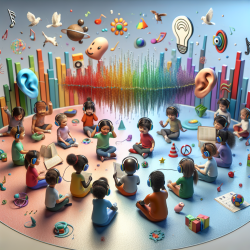In the field of speech-language pathology, data-driven decisions are crucial for creating effective interventions. A recent study titled "Effect of Noise Desensitization Training on Children with Poor Speech-In-Noise Scores" provides valuable insights into how practitioners can improve their skills and outcomes for children struggling with speech perception in noisy environments.
The study, published in the Canadian Journal of Speech-Language Pathology and Audiology, involved ten children aged 8 to 11 years with poor speech perception in noise. Five children underwent noise desensitization training (experimental group), while the other five served as a control group. After 15-20 training sessions, the experimental group showed significant improvement in their speech comprehension scores compared to the control group.
Understanding Noise Desensitization Training
Noise desensitization training involves systematic exposure to speech in noisy conditions to help individuals adapt and improve their speech perception. The training typically includes:
- Exposure to various types of background noise (e.g., white noise, multi-speaker babble)
- Gradual increase in noise levels
- Use of familiar and new speech materials
- Evaluation of speech comprehension at different signal-to-noise ratios (SNRs)
Key Findings and Implications
The study's results indicate that noise desensitization training can significantly enhance speech perception in noisy environments. Key findings include:
- Significant improvement in speech comprehension scores in the experimental group
- No significant change in the control group's scores
- Improvement observed in both monosyllabic words and sentences
These findings suggest that noise desensitization training can be an effective intervention for children with poor speech-in-noise scores. Practitioners can implement these strategies to help children improve their auditory processing skills and overall communication abilities.
Implementing Noise Desensitization Training
For practitioners looking to incorporate noise desensitization training into their practice, consider the following steps:
- Initial Assessment: Conduct a thorough assessment of the child's speech perception in noise using standardized tests.
- Customized Training Plan: Develop a training plan tailored to the child's specific needs, including different types of noise and varying SNRs.
- Regular Monitoring: Monitor the child's progress regularly and adjust the training plan as needed.
- Parent and Teacher Involvement: Engage parents and teachers in the process to provide support and reinforcement in different environments.
Encouraging Further Research
While the study provides promising results, further research is needed to explore the long-term benefits and potential applications of noise desensitization training. Practitioners are encouraged to contribute to this growing body of research by conducting their own studies and sharing their findings with the professional community.
To read the original research paper, please follow this link: Effect of Noise Desensitization Training on Children with Poor Speech-In-Noise Scores.










